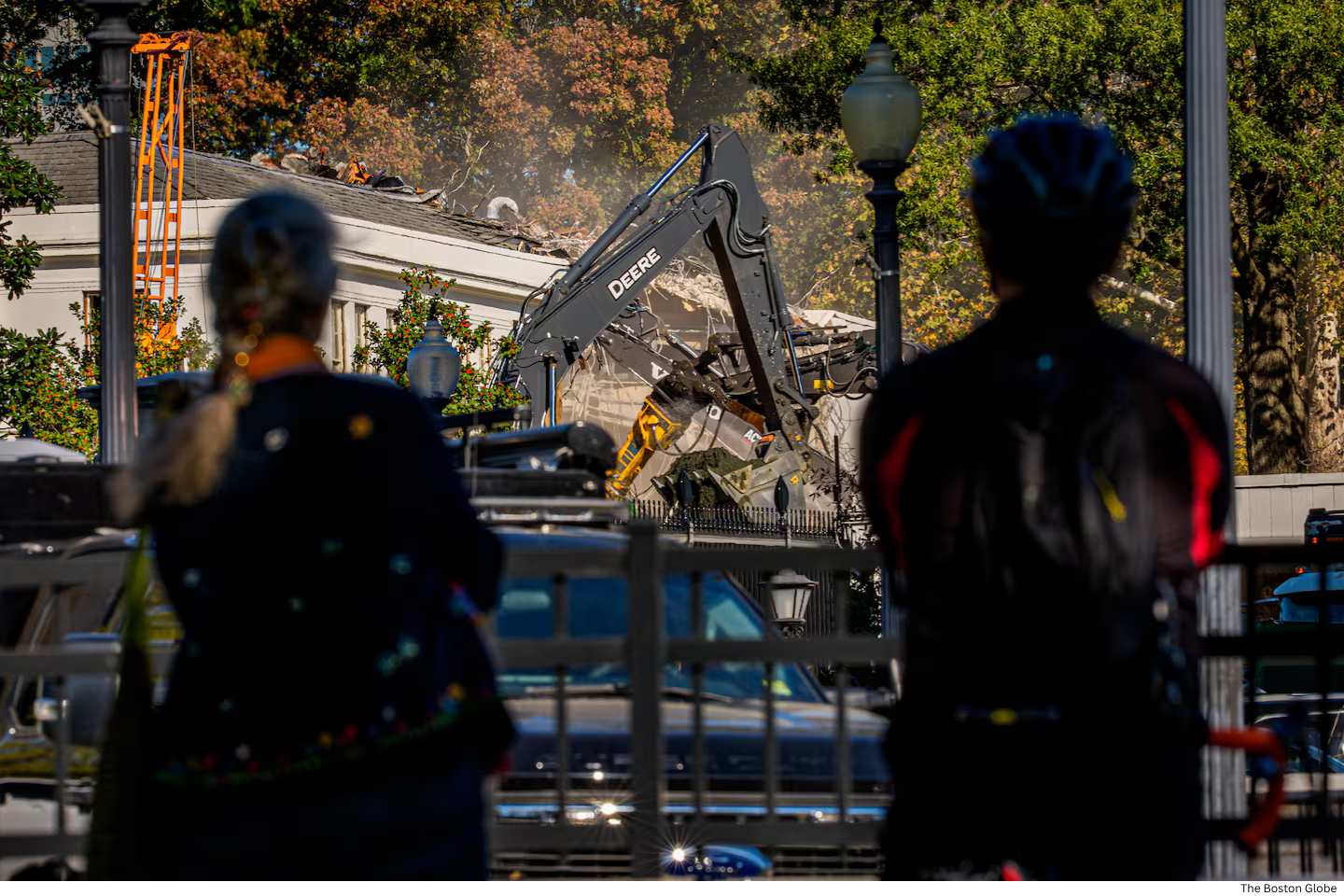Heavy machinery rumbled across the South Lawn this week as crews continued clearing the rubble of the White House East Wing, which has now been fully demolished to make way for President Donald Trump’s planned $300 million presidential ballroom. The ongoing project, captured in new satellite images and construction footage, marks one of the most dramatic architectural changes to the White House in decades — and one that has ignited debate among preservationists and political observers alike.
A Historic Wing Reduced to Rubble
Satellite photos taken Thursday morning reveal a striking image: the East Wing, long home to the First Lady’s offices and event spaces, is gone. What remains is a jagged outline of debris marking the footprint where the 100-year-old structure once stood.
From above, excavators can be seen digging through the piles of broken marble, stone, and steel. Construction crews have already begun consolidating materials to be hauled away, while a cement mixer waits nearby — a sign that foundation work for the new ballroom is beginning.
The demolition, which began earlier this month, has transformed the familiar symmetry of the White House grounds. The colonnade that once connected the Executive Residence to the East Wing has also been torn down, with only a small section still standing near the main building. The loss of that elegant walkway — a feature first designed in 1942 — has been particularly symbolic for many historians, representing the end of an architectural era.
Early Construction Begins for Trump’s Ballroom
While rubble still surrounds the area, early groundwork is already visible for the new White House Ballroom, a centerpiece project in President Trump’s larger plan to “modernize” the Executive Mansion for official and diplomatic use.
The new structure is expected to accommodate large-scale state events, fundraisers, and ceremonies that previously required off-site venues or temporary setups. According to preliminary renderings released by the White House, the ballroom will feature high ceilings, ornate chandeliers, and security-integrated infrastructure capable of hosting up to 1,200 guests.
In one of the satellite images, a small rectangular excavation appears to mark part of the new building’s foundation. Cement trucks and heavy equipment are stationed between the Treasury Department and the former East Wing site — visual confirmation that the project has moved beyond demolition and into early-stage construction.
White House Responds to Backlash
Facing questions from reporters, White House Press Secretary Karoline Leavitt addressed the growing controversy surrounding the scale of the demolition. Speaking at Thursday’s press briefing, she acknowledged that the scope of the project had “expanded over time” but urged the public to remain patient and “trust the process.”
“When this plan was presented, and when the renderings were complete, the president directed me to share them with all of you,” Leavitt said. “I gave an entire briefing about what this ballroom project was going to look like. With any major construction project, there are changes as you go — but we’re committed to transparency.”
She added that the administration would continue updating the public as new developments occur, though she did not respond directly to questions about whether the National Park Service or the Commission of Fine Arts — both typically involved in federal preservation projects — had formally approved the demolition.
Preservationists Raise Alarm
Critics have expressed alarm at both the speed and scope of the project. The East Wing, first completed in 1942 under President Franklin D. Roosevelt, served as a key operational area for the First Lady and her staff. It also contained public visitor facilities and the entrance to the White House Theater.
“The East Wing isn’t just an annex — it’s part of the White House’s architectural and historical identity,” said Dr. Mary Ellen Hodge, a historian with the American Institute for Historic Preservation. “To erase it so abruptly, without open review or documentation, is deeply concerning. The White House belongs to the American people, and its preservation should never be a unilateral decision.”
Photos circulating on social media show cranes hovering above the rubble and workers cutting through the last beams that once supported the colonnade. Many observers have compared the scale of the demolition to the Truman Reconstruction of the early 1950s, when the White House interior was gutted and rebuilt from within due to structural instability.
However, in that case, preservation was the core goal — not modernization. “Truman rebuilt the White House to save it,” said Hodge. “This project appears to be reshaping it for luxury.”
Supporters Defend Trump’s Vision
Despite the criticism, supporters of the project argue that Trump’s renovation will leave a lasting, positive legacy. They point out that past presidents — including Roosevelt, Truman, and Kennedy — all made significant changes to the White House during their tenures.
“Every generation leaves its mark,” said a senior administration official familiar with the project. “President Trump’s goal is to enhance the White House’s ability to host large diplomatic events and national celebrations, making it a more functional symbol of American prestige.”
Proponents also argue that the ballroom could become a major venue for state dinners and cultural exchanges, saving taxpayers money by reducing the need for expensive off-site events.
The official White House account on X shared several artist renderings of the project last week, showing a grand neoclassical hall with marble pillars, sweeping staircases, and intricate detailing inspired by early 20th-century American architecture.
Satellite Images Confirm Massive Footprint
The newly released satellite images have fueled both fascination and outrage online. The visuals — showing the East Wing’s complete absence and construction vehicles surrounding the cleared site — provide the clearest evidence yet of the project’s scope.
Construction analysts estimate that crews have already removed more than 6,000 tons of material from the site, including structural beams, foundation slabs, and masonry. Cement mixers and cranes remain on standby near the Treasury Building, signaling that foundation pouring could begin as early as next week.
Security has been tightened around the area, with temporary fencing, black tarps, and increased Secret Service presence. The remainder of the White House complex continues to operate normally, though sections of the South Lawn and the visitor entrance remain closed to the public.
Looking Ahead
According to administration officials, the new ballroom is expected to be completed in late 2026. Once finished, it will be one of the largest additions to the White House since the West Wing expansion under Theodore Roosevelt more than a century ago.
Still, questions linger over cost transparency, preservation oversight, and long-term impact. “This project is rewriting the architectural story of the White House,” said Dr. Hodge. “Whether history views it as a masterpiece or a mistake will depend on how it honors — or ignores — the legacy it replaces.”
As excavators continue to clear the last remnants of the East Wing, the debate over modernization versus preservation remains front and center — a reminder that even America’s most famous house is not immune to change.
%20(4).png)








